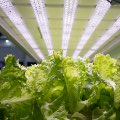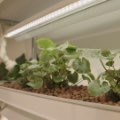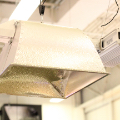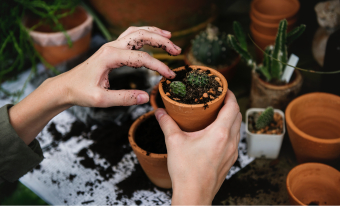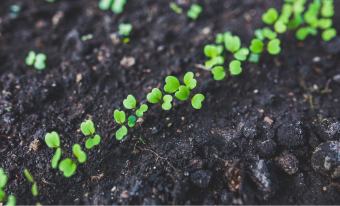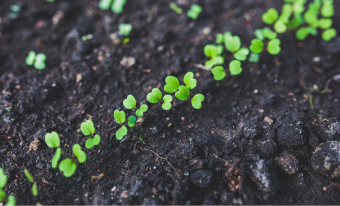
What Are LED Grow Lights?
LED grow lights are light-emitting diodes used for indoor gardening. Joining fluorescent and HID bulbs, LED grow lights provide growers with a reliable option for illuminating their gardens. Some even consider them the best all-around choice since they have superior coverage and faster results than other types of bulbs. In many instances, LED grow lights are more effective than the often-fickle sun itself, and help yield better tasting produce and lush greens. The ability to use them year-round is certainly an advantage, too. While buying LED grow lights is an investment, most find that the investment pays off.
How Do LED Grow Lights Work?
These grow lights work by transmitting rays of light — specifically, they target light in the spectral range of photosynthetically active radiation, sometimes adding UV and IR light to trigger certain plant responses. Different types of plants need light from the warm or cool portion of the color spectrum. With the right temperature, the light will facilitate the process of photosynthesis and increase the rate of growth for all sorts of plants and vegetables.
Warm and Cool on the Color Spectrum — What Is the Difference?
Different lights have different color temperatures, ranging from "warm" light (e.g., red and orange) to "cool" light (e.g., blue and violet). The difference is that certain LED grow light colors are better for specific types of plants or their processes. For instance, cool light tends to promote photosynthesis and growth, while warm light supports flowering or budding. Keep these two things in mind as you're shopping:
- Cool or High-Spectrum Light: Best for foliage, leafy greens and root crops.
- Warm or Low-Spectrum Light: Important for fruiting and flowering plants.
To make it easier, many LED grow lights offer full-spectrum or balanced lighting, allowing growers to adjust it according to their needs.
The Benefits of Using LED Grow Lights
You know that your indoor garden needs light, and you know there are a lot of options on the market. So, why should you go with LED grow lights over another type, like fluorescent or HID? While there are advantages to every kind of bulb, there's a good chance that LEDs will work best for your application.

#1: Efficient
You may have noticed that LED grow lights, especially the large setups and full-spectrum varieties, tend to be a bit pricier than their fluorescent counterparts. As such, your first question might be, "Is it worth it?" For most growers, the answer is, "Absolutely." While the upfront cost may be higher, LED grow lights use less electricity and last notably longer. That's in addition to the other benefits they'll bring to your yield. Also, there isn't just one type of LED grow light, and many options exist to fit within anyone's budget.
#2: Eco-Friendly
Because LED grow lights are energy-efficient, have long lifespans and produce more light per watt, they have a smaller environmental footprint than other types of lighting. Many growers are concerned with being "green," so this often has a big impact on their decision. And, once again, this means that you'll save on energy costs in the long run.
#3: Run Cooler, More Power
LED grow lights don't put out as much heat, which contributes to their energy efficiency. The cooler operating temperature reduces the risk of fire-related accidents. However, this does not diminish their power — despite the lack of heat, the best LED grow lights are capable of more powerful lighting than fluorescent bulbs.
#4: Better for Small Spaces
When it comes to indoor gardens, space is often at a premium. Since LED grow lights are usually more powerful, they can maximize light output per square foot. And since the heat output is lower, you can pack more lights into tight spaces without the risk of overheating.
#5: Versatile
Comparatively, LED grow lights are quite versatile. There are many options when you go to purchase them, depending on size, style and type of light. The good news is that all of them are relatively easy to use. Models that offer full-spectrum lighting are the most versatile since they can be used with all sorts of plants — and at all different phases of growth.
How to Choose the Best LED Grow Lights for Your Garden
So, you're convinced that LED grow lights will work well for your garden, and it's time to get buying! How do you decide? Well, there's more than one correct answer to that question for every single grower. A lot of it will come down to your specific needs. However, we can offer a few guiding principles that will help you find the best LED grow lights for your application.

What to Consider when Buying LED Grow Lights
This is not an exhaustive list, as there will be plenty of other points you need to consider when deciding which LED grow lights to buy. However, the following are pertinent to most growers:
- Budget
- Space
- Style of lighting for your plants
- Additional products you might need
Factors in the Cost of LED Grow Lights
Budgeting is essential to everyone. When you're shopping around, you'll see the following differences in terms of cost.
- Price Range: Low-budget, mid-budget and high-end models exist, with varying features determining their price.
- Standing or Hanging: Larger gardens may need hanging LED grow light fixtures, which tend to cost more, while standing models may be enough for some growers.
- Type of Light: Full-spectrum lighting is likely your best bet, but it may cost a bit more.
- Overall Footprint: If you need to cover a greater area, chances are the prices will go up.
Determining Your Space Requirements
Whether your plants are already set up, or you've simply decided where they'll go, you'll want to figure out the square footage of the area — only where there are plants, not any additional components. To calculate square feet, use measuring tape to get the width and depth, then multiply those two numbers together. Keep this number handy when looking at specifications of any LED grow lights you're considering. It will help you decide how many fixtures to buy or if a standing light will be enough.
Deciding What Style of LED Grow Lights Your Plants Need
Plants differ in the kind of light they require. Do some research on what yours will need, in terms of both wattage and color. As mentioned before, cool/high-spectrum lights are best for foliage, while fruits and flowers need more warm/low-spectrum light. Many models of LED grow lights do offer adjustable wattage and full-spectrum lighting, which is particularly helpful if you plan to grow different things throughout the year.
Finding Additional Products
To get the most out of your LED grow lights, you may also want to consider purchasing some other tools. In particular, grow tents can help your plants reach their full potential.
Some of the Best LED Grow Lights to Consider
When you first start your search, it may be a little overwhelming. Here are a few of our favorite LED grow lights to get you started. They're separated by budget to help you get an idea of what's out there.
Low-Budget
For those with less square footage to cover, the following are some solid options:
Mid-Budget
If you're looking for additional features while still staying within your price range, check out these LED grow lights:
High-End
For heavy-duty applications, consider this model:
Find The Best LED Grow Lights and More at Indoor Gardens
Are you ready to add some LED grow lights to your setup? We've got you — and your plants — covered. Browse Indoor Gardens' selection and contact us if you have any grow light questions. Happy gardening!
Shop LED Grow Lights Commercial Grower?
Commercial Grower?
